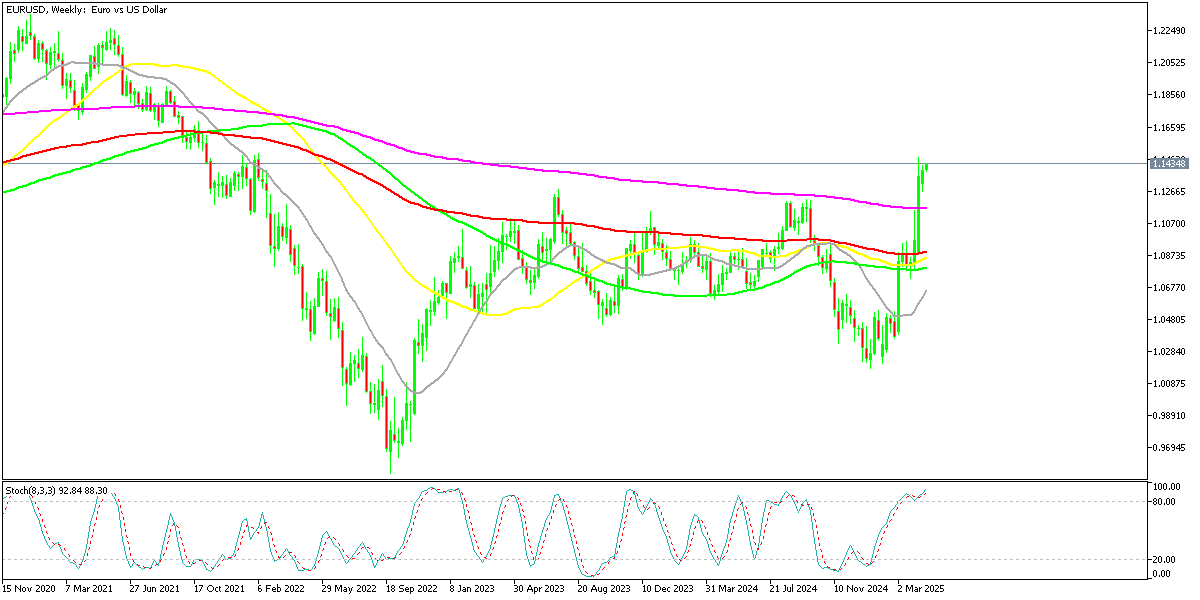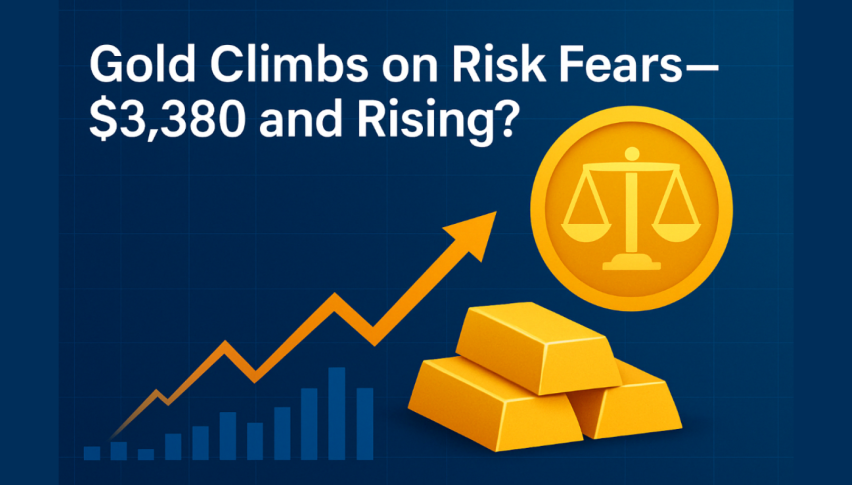Forex Signals April 21: DJIA and Tech Stocks Open in Focus After Volatile Week
This week delivers a number of manufacturing reports from major economies, as tariffs and trade anxiety have returned.
Skerdian Meta•Monday, April 21, 2025•4 min read
Quick overview
- This week features key manufacturing reports from major economies amid renewed tariffs and trade anxiety.
- Stock markets retreated as China's import restrictions on the US impacted tech stocks, with the Nasdaq down 0.5% and the Dow Jones losing over 1%.
- Gold reached a record high of $3,357, driven by global uncertainty and dovish Fed signals, while the euro strengthened against the USD.
- Bitcoin experienced volatility but rebounded to $80,000 following political comments that boosted risk asset optimism.
This week delivers a number of manufacturing reports from major economies, as tariffs and trade anxiety have returned.
Last week was relatively quiet compared to the previous weeks, as investor sentiment stabilized. US Treasury yields reversed and gave back some of the gains after the massive surge in the previous week, while the volatility in forex was pretty low, with the USD being on the soft side, and starting the new week today in the same way. The ECB cut interest rates by 0.25% but without much impact on the Euro.
Stock markets retreated lower after the massive gains in the previous week, as risk sentient got dented due to China’s decision to stop certain imports from the US such as Boeing, and exports, while there was a debate in the US Senate to stop high tech Chip exports to China, which hurt semiconductor and tech stocks. Nvidia, and other tech stocks such as Meta were among the major losers for the week.
That pulled Nasdaq down by around 0.5%, while Dow Jones (DJIA) lost more than 1% as medical insurance stocks declined, following some surging costs in UnitedHealth Q1 earnings results, which sent the UNH stock tumbling around 25% lower.
Gold continued to surge higher, printing another record high at $3,357 and buyers were back as soon as markets opened last night. Crude Oil turned bullish toward the end of the week, with WTI surging close to $65, but opened $1.50 lower last night, after weekend comments from US President Trump that a peace deal between Ukraine and Russia could be signed soon.
This Week’s Market Outlook: Have Tariffs Affected Manufacturing?
This week brings a dense slate of manufacturing data from major economies, just as tariffs and trade uncertainty have re-entered the macroeconomic conversation. Early indicators like PMI data and sentiment surveys (Richmond Fed, Ifo) will be closely watched for any softening in output, orders, or hiring.
Markets are especially focused on how trade tensions—particularly between the US and China—may be weighing on factory activity and business confidence. A downtrend across multiple manufacturing indices would strengthen the argument that tariff policies are starting to bite, especially in export-driven regions like Germany and sectors like semiconductors and heavy machinery.
The takeaway? If this week’s manufactuing data disappoints, it could fuel expectations for policy intervention (rate cuts, stimulus) from the ECB and BOE, and reinforce safe-haven flows into assets like Gold, JPY or the USD.
Monday – April 21
- Financial markets in Germany will remain closed for Easter Weekend.
- Expect lower trading volume in European sessions, potentially muting volatility.
Tuesday – April 22
- ECB President Lagarde Speaks
- US Richmond Manufacturing Index
Wednesday – April 23
Global Flash Manufacturing PMIs:
- Eurozone, Germany, UK, and US Flash PMIs released. These preliminary readings will offer a real-time glimpse into manufacturing activity. Markets will watch for soft prints that could hint at tariff-related slowdowns, particularly between the US, China, and EU.
- BOE Governor Bailey Speaks:
Thursday – April 24
- German Ifo Business Climate Index: Gauges sentiment among German manufacturers and businesses.
- US Weekly Unemployment Claims: Labor market health remains vital for broader economic resilience.
- US Existing Home Sales: Secondary but important consumer indicator; housing impacts demand for durable goods like appliances (often imported).
Friday – April 25
- UK Retail Sales (m/m): Reflects consumer sentiment and spending trends. A slump may signal downstream effects of tariffs and inflation on household purchasing power.
- SNB Chairman Schlegel Speaks: May comment on global economic headwinds and Swiss trade exposure to Europe and Asia.
- Canadian Retail Sales (m/m): Could provide another angle on North American consumption amidst tariff-related price pressures.
Last week, markets were chaotic, with gold soaring $250 in the final three days, the EUR/USD surging 5 cents, and stock markets opening down before turning upward. The moves were big, and the volatility was enormous, so we opened 40 trading signals in total, finishing the week with 25 winning signals and 15 losing ones.
Gold’s Historic Rally Finds Fuel in Dovish Fed and Global Uncertainty
After a modest decline at the start of April, gold swiftly reversed course and launched into a powerful rally. The yellow metal found solid footing around the 50-week simple moving average (SMA), which acted as a key technical support. Over the following two weeks, gold surged more than $400—marking the largest two-week advance in its trading history.
The rally was further reinforced by remarks from Federal Reserve Chair Jerome Powell, who signaled a cautious approach to future policy moves. Markets reacted swiftly, pricing in approximately 90 basis points of rate cuts by year-end, with speculation mounting that easing could begin as soon as June or July. This dovish sentiment contributed to further gains, propelling spot gold (XAU/USD) to a fresh all-time high of $3,357 before retreating slightly.
XAU/USD – Daily Chart
EUR/USD Soars on Weak Dollar and Trade Worries
The weakening U.S. dollar, coupled with escalating trade tensions between Washington and Beijing, has increased demand for traditional safe havens—lifting not just gold but also the euro. EUR/USD climbed steadily, breaking past the 1.1414 resistance level.
This move reflects growing market belief that the Fed is shifting toward a more accommodative stance. Interestingly, even with expectations of a potential ECB rate cut, the euro continues to hold firm. Traders now question whether the pair will even dip below 1.10 in the near term, signaling persistent dollar weakness and robust euro demand.
EUR/USD – Weekly Chart
Cryptocurrency Update
Bitcoin Steadies Amid Policy Shifts and Political Support
Digital assets mirrored the volatility seen in traditional markets, with Bitcoin swinging sharply on shifting central bank expectations and political developments. After a $5,000 surge driven by dovish Fed speculation, BTC took a steep dive, crashing below its 200-day moving average and briefly dipping under the $75,000 mark.
However, the mood quickly reversed following comments from former President Donald Trump, which rekindled optimism across risk assets. Bitcoin rebounded strongly, soaring $8,000 to reclaim the $80,000 level. Technical support at the 50-day moving average helped reinforce buyer momentum and renewed interest in crypto exposure.
BTC/USD – Daily chart
Ripple Holds Its Ground, Attracts Renewed Interest
Ripple (XRP) demonstrated remarkable resilience amid broader crypto market volatility. Despite sharp intraday swings, XRP managed to hold several critical psychological and technical support levels—$2.20, $2.00, and $1.80—bolstered by its 200-day moving average.
This stability didn’t go unnoticed. As confidence returned to the broader crypto sector, XRP began drawing investor attention once again. By midweek, it had regained the $2.00 handle, helping fuel a broader digital asset rebound. XRP/USD – Daily Chart
XRP/USD – Daily Chart
Skerdian Meta
Lead Analyst
Skerdian Meta Lead Analyst.
Skerdian is a professional Forex trader and a market analyst. He has been actively engaged in market analysis for the past 11 years. Before becoming our head analyst, Skerdian served as a trader and market analyst in Saxo Bank's local branch, Aksioner. Skerdian specialized in experimenting with developing models and hands-on trading. Skerdian has a masters degree in finance and investment.
Related Articles




 XRP/USD – Daily Chart
XRP/USD – Daily Chart


